Reproductions
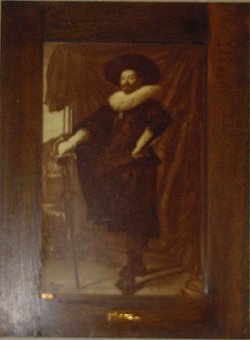
Admiral Huythuysen
Artist: Franz Hals (1580-1666)
Location: Hall from room 219 to 221
Catalog # 48
Notes: Class of January, 1913. Zest for life is evident in the vigorous portraits by Hals. He liked to paint "the things that are seen." He lacked insight into the deeper emotions but delighted in catching the expression of the moment.

Alfred the Great Rebuilding the Walls of London
Artist: Frank O. Salisbury (1874-?)
Location: Hall between room 117 to 119
Catalog # 66
Notes: Class of January, 1915. Original in Houses of Parliament, London. Kind Alfred is shown standing on two building stones, directing the repairing of the wall of London, which had been damaged by time and by the Danes.

Autumn Landscape
Artist: Florion G. Wisinger
Location: room 146
Catalog # 38
Notes: Class of June, 1913. This picture is impressionistic to the extent that it is a study of a momentary effect in light and color. It therefore lacks the emphasis on form for which many modern artist strive.

The Boy of Winander
Artist: Henry O. Walker (1843-1929)
Location: Library / room 002
Catalog # 325
Notes: Original in Library of Congress, Washington, DC. The boy (from Wordsworth's poem "The Prelude") is in a listening mood. Through his hands "he blew mimic hootings to the owl, that they might answer him". The picture illustrates a pause when surprised at the "voice of the mountain torrent" and with his mind filled with images of the scene, he became aware of the spirit in nature. The low key of color adequately portrays the solemnity of the hour.

Brunnehildes Erwachen (Brunnehilde's Awakening)
Artist: Hermann Hendrick (1856-1931)
Location: Hall from room 334 to 338
Catalog # 60
Notes: Class of June, 1913. Unlike the story in the tradition where Siegfried awakens Brunehilde, the artist shows an ethereal figure emerging from mystic clouds.

Call of the West Wind
Artist: Charles Harold Davis (1856-1933)
Location: Archive Room
Catalog # 242
Notes: The original hangs in the Butler Art Collection in Youngstown, Ohio.

Captain Lewis Sighting Yellowstone
Artist: n/a
Location: room 104D
Catalog # n/a
Notes: No information available

Charles I. Demanding the Five Members of the Guild Hall
Artist: Solomon J. Solomon (1860-1927)
Location: Hall between room 117 to 119
Catalog # 65
Notes: Class of January, 1915. Original in Houses of Parliament, London. On January 31, 1642, King Charles I entered the House of Commons and demanded that this legislative body turn over to him five leaders of the opposition. These leaders, who included John Pym and John Hampden, had protested and acted against Charles's over assumption of authority. They were not present. The picture shows him demanding the persons of the so-called offenders. King Charles is the central figure.

The Concert
Artist: Giorgione da Castelfranco (1478-1511)
Location: Hall from room 219 to 221
Catalog # 369
Notes: With Giorgione began a new era in art. His pictures mark a departure from conventionalized forms for strictly religious purposes. for the first time, art became an expression of beauty as the artist conceived it.
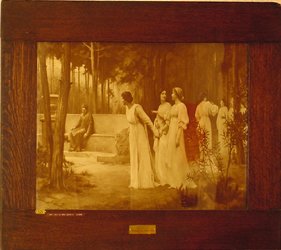
Dante Weeping Over Beatrice
Artist: M. Rieder (1852-)
Location: room 229
Catalog # 125
Notes: Class of January, 1913. On the marble bench in the garden, Dante mourns for the dead Beatrice. He does not notice the ladies who sympathize with his grief and would comfort him.

Die Schlafende Bruhilde (Sleeping Brunnehilde)
Artist: Hermann Hendrick (1856-1931)
Location: Hall, corner to room 332
Catalog # 56
Notes: Class of June, 1913. Notice the original interpretation of the story of Brunnehild's punishment. The fiery illumination shows the artist's range in the use of color.

Endymion
Artist: Henry O. Walker (1843-1929)
Location: Library / room 002
Catalog # 327
Notes: Original hangs in the Library of Congress, Washington DC. This picture tells the story of Endymion, the shepherd youth, as he lay asleep on Mt. Latmos. Diana from her chariot of the moon, beheld and loved him. The radiance of light in which he forever sleeps creates an atmosphere befitting the beauty of the theme.

The Falconer
Artist: Rembrandt Van Rijn (1606-1669)
Location: Hall from room 323 to 325
Catalog # 119
Notes: Original in National Gallery, London. Comparison of "Portrait of an Aged Woman" and "The Falconer" reveals similarities of method. Both have the effects of light in the central portion, surrounded by dark masses. Note that the falconer's eyes are in the light, while the falcon is subordinated by being in the shadow.

Freya's Garden
Artist: Hermann Hendrick (1856-1931)
Location: Hall, corner to room 332
Catalog # 52
Notes: Class of June,1913. This scene interprets an episode featuring Freya, the Scandinavian goddess of spring and love. She is shown in her heavenly garden, which she tends and guards. With her apples she keeps the gods forever young. The slender trees and delicate colors are buoyant.

Glitter of the Sea
Artist: Konrad Muller-Kurzwelly (1855-1914)
Location: room 123
Catalog # 296
Notes: The feeling of great depth in this picture is due to the subtle use of diagonal lines leading the observer to the seas, where the full weight increases the vastness. The natural coloring of the heather on the shore contributes to the decorative quality of this picture.

Harbor Lights
Artist: Harry A Vincent (1867-1931)
Location: room 225
Catalog # 282
Notes: The effect of light is felt as it transforms freighters and tugs alike into phantom ships with gossamer ropes and unsubstantial masts. The patterns of vertical lines and the workmen, seen but dimly through the shadows, create mystery. This is deepened by the green, blue, blue-green, and purple falling mistily over the night. A careful balance is maintained by the smaller boats. Their diagonal lines suggest that their departure will soon destroy this ephemeral beauty.

A Home Scene
Artist: Pinter
Location: Hall from corner to room 132
Catalog # 384
Notes: Harmonious blending of warm colors and informal arrangement of masses and figures contribute to the cheerful aspect of motherhood in this realistic composition.

Italian Landscape
Artist: Arthur Davis (1862-1928)
Location: room 201
Catalog # 417
Notes: Original at the artist's estate. To this romanticist the mountains of Italy appealed poetically. The composition is decidedly in horizontal lines, rhythmically repeated in the mountains, in the outline of the village, in the color, and in the forms of the herd. The imaginative quality is further suggested by the absence of strong contrasts in line, in dark and light, or in color. The close relation of values in the grayed colors and in lines tends to make a decorative pattern, such as that found in tapestries.

Kashmir
Artist: John Singer Sargent (1856-1925)
Location: Room 102D
Catalog # 403
Notes: Sargent, the most popular portrait-painter of his time, was particularly adept at handling brush and paint in a spontaneous manner to secure clear, fresh, sparkling color, well unified with the glittering society he most frequently painted. Unfortunately, this type of painting, though requiring genius, tends to emphasize the surface of characterization and lacks the depth of feeling and interpretation necessary for the timeless masterpieces. It is in such a decorative mural as this that Sargent's talent shows at its fullest. Here he idealized womanhood instead of painting the beauty of the individual.

King Lear
Artist: Edwin A. Abbey (1852-1911)
Location: Hall from room 229 to corner
Catalog # 300
Notes: Memorial to Isaac Chase Libby, head of the Latin department for 26 years. Original hangs in the Metropolitan Museum of Art, New York. Abbey here portrayed one of the supreme moments in tragedy. His picture, based on Shakespeare's King Lear, expresses the upheaval in man's nature when the bond between parent and child is broken. The old king's bowed and feeble form, as he leaves the room after denouncing Cordelia shows, symbolically, that his character has been destroyed. Through use of contrast in light and shade, Cordelia, rebuking Goneril and Regan, is ennobled by indignation. The French king, her suitor, feels her sublimeness. The rhythmic color aids in interpreting the emotional character of Abbey's theme. The richness of court costumes of the twelfth century forms the decorative element in this picture.

Late Afternoon
Artist: George Innes (1825-1894)
Location: Hall from room 033 to 035
Catalog # 233
Notes: Though Inness in his earlier painting made realistic studies of nature, he later developed an original style. He simplified details and painted effects of light and color in broad masses without sacrificing the truths of nature while expressing the artist's emotions and thought. In this picture the magnificence of the trees is heightened by balance.

Madam Le Brun and Daughter
Artist: Madam Vigee Le Brun (1755-1842)
Location: room 109
Catalog # 88
Notes: Donated by the Class of 1895. Original in Louvre, Paris. Although the popularity of Madame Le Brun has passed, in the history of art she is important, because she was among the first great women artists recognized as contributing something definitely feminine to art.

The Meeting of Wellington and Blucher
Artist: Daniel Maclise (1806-1870)
Location: room 201 / Balcony Entrance
Catalog # 240
Notes: Original in House of Parliament, London. Arthur Wellesley, Duke of Wellington and soldier and statesman, was sent to head the British forces opposing Emperor Napoleon I and to cooperate with Field Marshal Blucher of Prussia. They met on June 15, 1815, in the windmill at Bry, to discuss their plans.

Mont St. Michel
Artist: V. Brugairolles
Location: Hall from room 327 to 329
Catalog # 279
Notes: The large rock, Mont St. Michel, dimly outlined on the horizon, merely identifies the location of this scene on the coast of France. The artist's purpose was to transfer to canvas the golden glow on land, sea, and sky as he saw it at sunset.

Mrs. Richard Brinsley Sheridan
Artist: Sir Thomas Gainsborough (1727-1788)
Location: Hall from room 029 to 031
Catalog # 41
Notes: Original in National Gallery, London. In this exceptional portrait Gainsborough's manner of seeing was English. Her set an example of brilliant simplicity, conceived imaginatively; it is not a portrait of "trumped-up prettiness" but a likeness tempered by the artist's charming personality.

Native American
Artist: n/a
Location: West Hall to Auditorium
Catalog # n/a
Notes: No information available

The Night Watch Guard
Artist: Rembrandt Van Rijn (1607-1669)
Location: Hall from room 323 to 325
Catalog # 298
Notes: This, the largest canvas painted by the Dutch master Rembrandt, is more than a picture. It is a dramatic rendering of a company of militia, a mass of moving figures; a bright light and a profound darkness. Illuminated faces, shadows, gloom, and darkness are harmonized and contrasted with striking boldness and unsurpassed art. The picture is not a study of individual officers and therefore proved a blow to their vanity. It ruined Rembrandt's profession as a portrait painter, but it is today acknowledged to be a masterpiece.
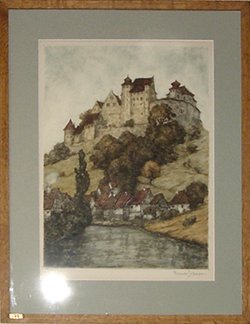
An Old Castle
Artist: Alexander Liebman
Location: hall from room 133 to 135
Catalog # 89
Notes: The old castle on top of the hill dominates the scene and looks down on the cottages along the river.

Peasant Family Scene
Artist: n/a
Location: room 104A
Catalog # 11
Notes: No information available. Refer to "First Steps, after Millet" by Vincent van Gogh.
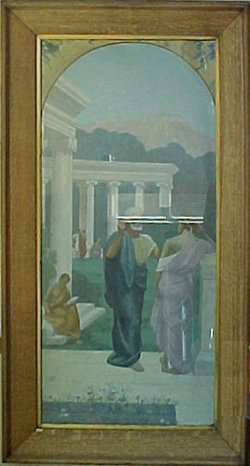
Philosophy
Artist: Puvis de Chavannes (1824-1898)
Location: 1st floor south-east stairway
Catalog # 268
Notes: Puvis de Chavannes is one of the 19th century's most famous painters of mural decoration. In his prodigious pictures of the pantheon, the Sorbonne, Amiens, Lyon, Marseille, Poitiers the personages, like the architectural subjects, seem to animate themselves in the mists as in an epic dream.
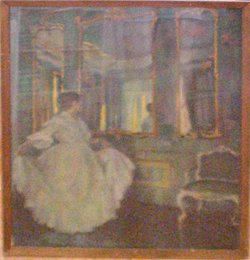
The Picture in the Large Mirror
Artist: Joseph Kuhn
Location: room 119
Catalog # 301
Notes: This Impressionist painting with its figures posed before a large mirror, suggests an ornamental setting in a French drawing room. Gilded frames and polished wood enhance the effect. The light, reflected from the white dress, the mirror, and the flossy floor, is predominantly cool and restrained. The figure itself gives the same sense of serves. Perhaps the painting is slightly too thin, too wanting in vitality, to be great art. Its main value resides in its decorative color.

The Prophet Jeremiah
Artist: Michelangelo (1475-1554)
Location: Hall from room 211 to 213
Catalog #391
Notes: Jeremiah, a figure of nobility and power, sits lost in reflection, his mood that of despondency. The composition forms an oval. Into this the large figure is drawn with strong, down-drooping lines. The spiritual colors express the hope found in his prophecies, filled through these are with warning and denunciation.

Protestant Reformation: Latimer Preaching Before Edward VI at St. Paul's Cross
Artist: Ernest Bord
Location: Hall between room 104 to 105
Catalog #69
Notes: Donated by the Class of January, 1915. Original hangs at the House of Parliament, London. This painting illustrates a scene on the theme of the Protestant Reformation. Hugh Latimer, English bishop and Protestant reformer, is preaching to Edward VI. Latimer was the favorite teacher of King Edward, who, being ill, had a pulpit placed in his garden that he might listen to Latimer's sermons.

Queen Elizabeth's Visit to the First Royal Exchange
Artist: Ernest Crofts (1847-1911)
Location: room 201 / Balcony Entrance
Catalog #75
Notes: Donated by the Class of January, 1915. Original in Houses of Parliament, London. This picture shows Queen Elizabeth on a visit to the Royal Exchange, founded in 1560 by Sir Thomas Gresham for the merchants who had previously had to transact their business on the streets. Surrounded by courtiers and guards and mounted on a white horse, the Queen is welcomed before the large, brick building. She was so pleased that she caused a herald to proclaim with trumpet that "Gresham's Exchange" was The Royal Exchange.

Reading Hermit
Artist: Solomo Koninck (1629-1678)
Location: Hall from room 029 to 031
Catalog #82
Notes: Original in Dresden Gallery. Koninck, a pupil of Rembrandt, shows his master's influence in handling light and in interpreting character.
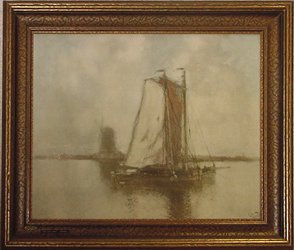
The Sail Boat
Artist: Karl Leipold (1864-?)
Location: hall from room 131 to 133
Catalog #350
Notes: This picture is a very beautiful aquarella, as the art critics call it. A gray-white sea and gray-white clouds form the background for a ship at anchor, with sails set and flags at mast.

Siegfried's Tod (Siegfried's Death)
Artist: Hermann Hendrick (1856-1931)
Location: Hall from room 338
Catalog #63
Notes: Donated by the Class of June,1913. An eclipse of the sun marks the tragic moment of the death of Siegfried, who, in the Norse saga, is the personification of light. Through gloomy shadows, the eye of the observer follows the group of indistinct figures that reveal this joyless story by their various postures: the Rhine maidens, who had been trying to coax the Ring from Siegfried, entreat with uplifted hands; the noble Siegfried, stabbed by Hagen, lies prone; the wicked Hagen almost enveloped in darkness, skulks treacherously. The scene is on the Rhine River, where Siegfried had strayed from his companions on a hunting expedition.

pring
Artist: Jean Babtiste-Camille Corot (1796-1875)
Location: room 212
Catalog #24
Notes: Donated by the Class of June, 1912. Original in the Louvre, Paris. Corot's purity of conception reveals itself in the gradation of color in the sky and in the play of sunlight through the leaves. The upward movement of the lines suggests the exultation of spring and conveys a religious devotion to nature.

Still Life
Artist: J. Lindner
Location: room 146
Catalog #344
Notes: The objects in this "still" group are ones that lend themselves to beauty: the scarf, the dish, the bowl of flowers, the decorative tapestry.

The Storm
Artist: Constant Troyon (1810-1865)
Location: room 105
Catalog #353
Notes: In this scene, Troyon expresses unity in nature through his harmonious handling of light, color, and masses.
The Surrender of Brenda (picture not available)
Artist: Diego Rodriguez de Silva Velasquez (1599-1660)
Location: Between stairway doors
Catalog #215
Notes: Original in Prado Gallery, Madrid, Spain. Strong contrasts vitalize and humanize this scene as Marquis de Spinola grasps the hand of Justin of Nassau, who, at the second capture of the Dutch town of Breda by the Spaniards in 1652, surrenders the keys. This picture is not only one of the greatest of historical pictures but one of the most magnificent. it is made such through the controlled movement in every part of the composition and through genius in organizing complex material. Observation of the contrasts and the balances in this composition will give understanding of the art of this great painter. The vertical lines at the right have caused the picture to be named, "A forest of Lances."

Tiger
Artist: n/a
Location: room 104D
Catalog #n/a
Notes: No information available

Thomas Carlyle
Artist: James Whistler (1834-1903)
Location: room 148
Catalog #146
Notes: Donated by the Class of June, 1915. Original in Glasgow, Scotland. Whistler was not interested in a psychological analysis of his subject as a sour old man. The painter's purpose was to create a decorative picture by means of arrangement and a melody of line and harmony of color.

Wallkrenstrum (Flight of the Valkyries)
Artist: Hermann Hendrick (1856-1931)
Location: Hall, corner to room 332
Catalog #55
Notes: Donated by the Class of June,1913. The Nibelungs' ring, accursed and bringing a curse, symbolized greed for gold. It threatens even Valhalla with destruction. Wotan (Odin) himself engages in the struggle to save Valhalla. The flight of the Valkyries across a storm-swept sky evokes the Teutonic spirit.
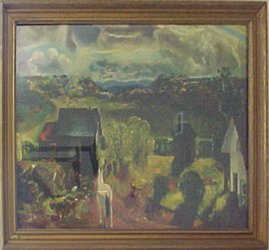
White Horse
Artist: George Bellows (1882-1925)
Location: room 131
Catalog #418
Notes: Original at Worchester, MA. Abrupt and disconcerting are the changing harmonies and dissonances throughout the picture; unexpected the turns of hand by which the tumult comes to life. There is a tremulous strip of light and shade, all gold and silver, where willow boughs interrupt the sun a little as it falls on the weathered side of a wooden shed. The whole passage, due to foreshortening, is less than an inch across, yet the complete illusion of exquisitely drawn detail in color and design is there, who delicacy is matched only by the casualness with which it is evoked.

Wotan
Artist: Hermann Hendrick (1856-1931)
Location: Hall from room 338
Catalog # 62
Notes: Donated by the Class of June,1913. Completely enveloped in the deep shadows of dusk, Wotan, with spear broken and power destroyed, is a lonely figure, as he watches the setting sun, a symbol of the twilight of the gods. The sharp lines in the precipice cut off all action for Wotan in the future.

Adonis
Artist: Henry O. Walker (1843-1929)
Location: Library / room 002
Catalog # 326
Notes: Original in Library of Congress, Washington, D.C. Adonis, a hunter, is loved by Venus. Unmindful of the goddess, he leaves her and hunts the wild boar, which kills him. Shakespeare used the Greek myth as the theme of a poem entitled, "Venus and Adonis." By downward sloping lines and by the pallor of the youth, a noble form, Walker creates the tragic scene which awaits the sorrowing queen of love.

The Apostles
Artist: Albrecht Durer (1471-1528)
Location: room 229
Catalog # 35
Notes: Original at Munich, Germany. Durer, considered the greatest engraver of all time, is Germany's representative artist. He brought the spiritual warmth of the Italian Renaissance to the art of the North. "The Apostles", one of his most popular paintings, is a diptych or two-part altar piece, representing on one tablet the apostles John and Peter; on the other, Paul and Mark.

The Avenue of Trees
Artist: Meyndert Hobbema (1637-1709)
Location: Hall from room 311 to 313
Catalog # 76
Notes: Original in National Gallery, London. The artist, through the genius of his painting, has made a great picture from simple landscape material. The painting is evidence that simplicity is synonymous with great art.

Bradbury's Millpond
Artist: Henry Ward Ranger (1858-1916)
Location: Business Office
Catalog # 230
Notes: This color reproduction is painted so sympathetically that it is easy to believe that the artist was moved emotionally by the pond.
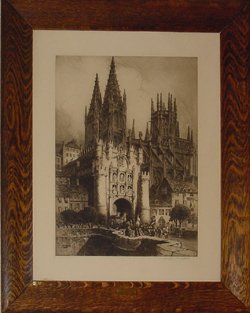
Burgos Cathedral
Artist: Andrew F. Affleck (1221-1567)
Location: Hall from room 345 to 345
Catalog # 227
Notes: Class of June, 1918. This etching should be studied as typical of Spanish Gothic. The contrasts are due, partly, to climatic conditions. As the climate of Burgos is hot and dry, the vaults of the cathedral either were left exposed or were covered with tiles. Thus the roof is flat or low-sloped. As the sunshine is hot and brilliant, the number of windows was lessened. The wall space is plain. Characteristic Spanish decoration reveals a combination of Islamic and Christian motifs and also love of the full, overloaded design, which lacks the restraint of the French.

Cardinal Wolsey at the Trial of Catherine of Aragon and Henry VIII at Blackfriars, AD, 1529
Artist: Frank O. Salisbury (1874-?)
Location: Hall between room 117 & 119
Catalog # 64
Notes: Class of January, 1915. Historical painting in Houses of Parliament, London. Aside from the historical significance, this series from 64 to 75 inclusive, is outstanding for brilliance of coloring and richness of decoration. In this picture the artist shows a famous event, the divorce trial of King Henry VIII and Queen Catherine, daughter of Ferdinand of Aragon and Isabella of Castile. Cardinal Wolsey, having been given jurisdiction by Pope Clement VII, presides upon the judge's throne. Queen Catherine, having made many futile efforts to defeat Henry's purpose, is shown in court as she flings herself at the Cardinal's feet to beg for justice. The rights of the woman, the church, and the state are in the balance. The position of the kneeling queen intensifies the scene.

Children of the Shell
Artist: Bartolme Estaba Murillo (1618-1682)
Location: room 201
Catalog # 104
Notes: Class of January, 1913. Original in the Prado Gallery, Madrid, Spain. The triangular arrangement, the repetition of the diagonal lines, and the striking contrast between light and shade give balance and strength to this charming picture. The innocence and artlessness of childhood are delightfully portrayed. The prophetic lines of the reed cross, with the Latin inscription, Behold the Lamb of God, suggest but do not emphasize the religious symbolism.

Coronation of the Virgin
Artist: Fra Beato Angelico (1387-1455)
Location: Hall from room 223 to 225
Catalog # 419
Notes: Original in the monastery of San Marco, Florence, Italy. Angelico painted this resplendent, religious scene with surpassing art. The center of interest is Christ seated on a throne with marble steps of varied colors, each of which is symbolic. He is about to place a crown of rich workmanship upon the head of his kneeling mother. Circles of angel-musicians and saints are repeated about the Virgin, their long trumpets filling the space above. In the lower part of the picture, faces lifted, are the hosts of the blessed in two groups. Each saint is distinguished by an emblem or by his name on his nimbus or on his vestment. Conspicuous in the lower-right corner are St. Agnes holding her little, white lamb in her arms, the lamb symbolizing purity; and St. Catherine leaning on her wheel as calmly as if it were a spinning wheel instead of an instrument of her execution. These celestials, in their chaste draperies of white, rose, and blue, sown with stars and embroidered in gold, form a luminous and harmonious background for this famous masterpiece.

Don Ballhazer Carlos
Artist: Diego Rodriguez de Silva Velasquez (1599-1660)
Location: Hall from room 029 to 031
Catalog # 214
Notes: Class of June, 1917. Original in Prado Gallery, Madrid, Spain. This picture of the son of Phillip IV of Spain has a gaiety that is rare in Velazquez's work. Don Carlos and his gay, galloping, impossibly rotund pony seem to have abandoned themselves to the mountain air. They give a complete impression of form revealed in atmosphere and maintain an unusual feeling of movement, mainly owing to the strong contrast in structural rhythm between the foreground and the background.
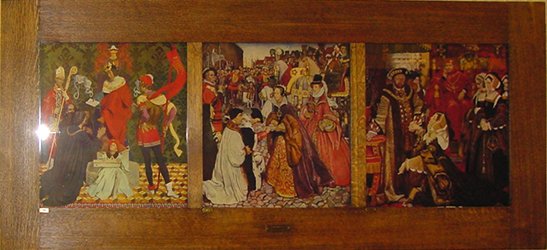
Entry of the Queen into London
Artist: Bryan R.I. Shaw (1872-1919)
Location: Hall between room 104 to 105
Catalog # 74
Notes: Class of January, 1915. Original in Houses of Parliament, London. After Mary Tudor, daughter of Henry VIII and Catherine of Aragon, at the head of thirty thousand men took the crown, she was proclaimed queen at London. The artist shows Queen Mary at the Tower of London. Through repetition the kneeling prisoners of state form the dominant note, but by contrast enhance the majestic figure of the queen, who is raising them and forgiving them.
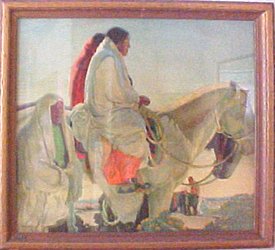
Fiesta Day
Artist: Victor Higgens (1884-)
Location: room 119
Catalog # 415
Notes: Original at Youngstown, Ohio. This picture belongs to a type of art devoted to regional subjects in America. Tribal costumes in light values and the sharp delineation of character show the Indian as a picturesque figure.

The Ford
Artist: Jean Babtiste-CamilleCorot (1796-1875)
Location: room 105
Catalog # 25
Notes: Class of June, 1912. Original in the Louvre, Paris. The movement of the herd toward the shadowy trees is only a variant of Corot's ability to make us feel the poetic aspect of nature.

Fruit Porters
Artist: William Francis Brangwyn (1867-?)
Location: Outside of room 131
Catalog # 375
Notes: Original in the dining room at Lloyds of London. Here lines reproduce the effect of pose rather than labor; yet the total effect expresses another phase in Brangwyn's original intention. Not only has he represented the same scale throughout, but he has effected transition by means of color, a blue contrasted with an orange accent to form a complementary scheme.

Golden Autumn
Artist: O. Jernberg (1826-1896)
Location: Hall from room 313 to 315
Catalog # 291
Notes: Northern art is characterized by restraint and dignity. The harmony of this golden autumn scene reflects Jernberg's sensitiveness to the pastoral.

The Immaculate Conception
Artist: Bartolome Esteban Murillo (1617-1682)
Location: Hall from room 229
Catalog # 389
Notes: Original in the Louvre, Paris. In studying a painting by Murillo it is necessary to know that he had three styles, distinguished by the Spaniards as cold, vaporous, and warm. In his cold style he broadly, boldly, and frankly painted his beggars true to life; in the vaporous manner he rendered the saint's ecstasies; in his warm style he pictured his gentle, graceful Madonnas. "The Immaculate Conception" is in the third style. The Virgin is painted with deep, religious feeling. The picture was inspired by a verse from Revelations describing "a woman clothed with the sun, the moon under her feet". The group of angels in the lower part of the picture are massed to give stability to the composition; the others form an outline about the Virgin's figure, whose contour is given by means of graceful lines. Mary's rove in white and blue symbolizes innocence, truth, and eternity. The beautiful golden light aids in idealizing Mary. The whole is a superb work, a harmonious and well-balanced composition of the greatest richness of color.

Jan Sobiesky
Artist: Rembrandt Van Rijn (1606-1669)
Location: Hall from room 343 to 345
Catalog # 114
Notes: Donated by the Class of January, 1913. Original at St. Petersburg, Russia. This portrait represents a vigorous, though rather vulgar type, a man whose inner life is betrayed by his massive neck, full flesh, and other coarse features. The details of light and color in the background and the costume are perfect. Sobieski was the Polish general who broke the siege of Vienna by the Turks in 1683. He had his soldiers haul their big guns over the Wienerwald (the Vienna Woods)… which are a a range of high hills behind the city). They swooped down on the Turks from the rear, and routed the Ottomans. The Vienna City Museum has a number of souvenirs, including the Sultan’s tent, which was abandoned in haste.
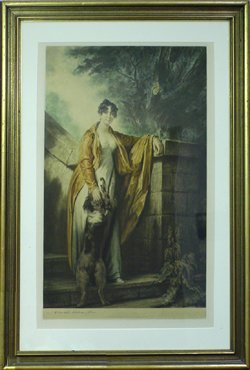
Lady and Dog
Artist: Sir Henry Raeburn (1756-1824)
Location: room 148
Catalog # 386
Notes: Raeburn's style is characterized "by the simple directness with which he viewed his subject and the broad, characterful way in which he rendered what he saw."

A Landscape
Artist: Luigi Kashmir
Location: Hall from room 305 to 307
Catalog # 86
Notes: Donated by the Class of June, 1915. Kashmir, who ranks among the foremost contemporary artists, is conservative. His style shows nothing classed as "modern."

Life
Artist: Napier Hemy (1841-1917)
Location: Hall from room 309 to 311
Catalog # 354
Notes: The joy of life is seen in every line of this picture. The taut young figure at the sail enjoys his struggle with it.

Madonna
Artist: Giovanni Cimabue (1240-1302)
Location: Hall from room 223 to 225
Catalog # 414
Notes: Cimabue is called the father of Italian painting. because his pictures of the Madonna and the Christ-child were truer to nature than any other previously painted. His figures, though not graceful, are more lifelike than other Byzantine, formal types he studied. A feeling for linear patterns led him to use the gently-bending angels, whose action leads the eye to the Madonna. The nimbus, a band of light, was used by medieval painters as a symbol of holiness. Cimabue inspired by Byzantine mosaics used universal, static symbols in a flat manner.

Memories
Artist: John W. Alexander (1856-1915)
Location: room 207
Catalog # 220
Notes: This picture is an allegorical concept set against a decorative background. It displays two girls, emphatically sinuous in form and vibratory in color. One girl, seated and wearing a dark, figured gown, balances the other girl, half reclining and wearing a coppery green, glowing garment. The dull red in the foreground is repeated in the rose-hued distance, leading to the suggestion that the memories of youth must be happy recollections.

Moonlight on the Scheldt
Artist: Heran Chaban
Location: Hall from room 131 to 133
Catalog # 385
Notes: This modern etcher creates decorative studies in line and color. The dark values in the boats contrast with the light values in the sky and water in the characteristic effect seen in his other etchings in the Lewis and Clark collection.

Mrs. Richard Brinsley Sheridan
Artist: Sir Thomas Gainsborough (1727-1788)
Location: Archive Room
Catalog # 273
Notes: Original in the Morgan Collection, London. In the Mrs. Sheridan of this picture Gainsborough aimed at interpreting her later pride, which is felt in posture, costume, and expression.

Near The Cradle
Artist: Franz Cherlet (1852-1928)
Location: room 05
Catalog # 19
Notes: Donated by the Class of January, 1912. This French etching blends the golden tones of brown into the warmth of the simple home. The blue of the child's dress adds freshness in the promise of youth.
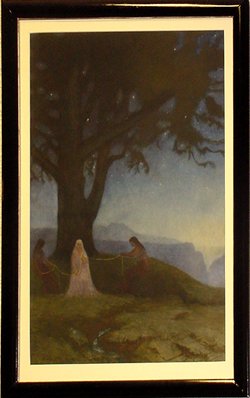
The Norns (The Fates)
Artist: Heroomann Hendrick (1856-1931)
Location: Hall from room 334 to 338
Catalog # 61
Notes: Donated by the Class of June, 1913. The slender thread of destiny, woven and measured by the Norns or Fates, is the center of interest. They weave in the shades of night. When the thread breaks, they know that the end of the gods is near. In theme and composition, the picture is somber and weird.

On the High Seas
Artist: Hans Peterson
Location: n/a
Catalog # 292
Notes: This picture has the verve that gives spirited expression to sea and ship. The grayness in the tones of color indicates the blustering day. This characteristic is also brought out by the full-blown sails.

Per Aspera Ad Astra (Through Difficulties to the Stars)
Artist: K.W. Dieffenbach
Location: room 038
Catalog # 330
Notes: Original at Capri, Italy. Disturbance and flight mark the movements of ducks, frog, hound, and monkey in their fright at the daring leap of the horse encouraged by his confident rider.
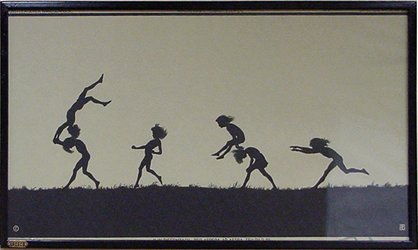
Per Aspera Ad Astra (Through Difficulties to the Stars)
Artist: K.W. Dieffenbach
Location: room 038
Catalog # 333
Notes: Original at Capri, Italy. The design and feeling of animation in this picture are united to interpret the buck's disposition as he leads the doe and fawn, followed by dancing figures.

er Aspera Ad Astra (Through Difficulties to the Stars)
Artist: K.W. Dieffenbach
Location: room 038
Catalog # 335
Notes: Original at Capri, Italy. In this picture rhythmic daring is emphasized.

Picture Writing
Artist: John W. Alexander (1856-1915)
Location: Library / room 002
Catalog # 251
Notes: Donated by the Class of June, 1919. Original hangs in the Congressional Library, Washington, DC. Alexander believed that mortality and beauty are inseparable in the highest forms of artistic expression. In this scene, in which the Indian is recording by picture-writing his unlettered story of war and the chase, the artist emphasizes the sinuous form; the bright, bold, and harmonious in color; and the theme that the highest happiness consists in living the beautiful life of self-forgetfulness.

The Prophets (from Creation)
Artist: Michelangelo (1475-1564)
Location: Hall from room 331 to stairs
Catalog #100
Notes: Memorial to J. Herman Beare, Head of the English Department for three years. Original on ceiling of Sistine Chapel in the Vatican, Rome. 1. Joel, reading the scroll, has an expression of absorbed interest. The painter did not derive his great figures form nature. He made them from his fund of accumulated knowledge, inventing new proportions and attitudes. Yet the figures are not mere examples of anatomic skill. They are interrelated forms charged with vitality and inspired by the noblest outpourings of the soul. 2. Zacharias, turning the leaves of a book, seems engaged in an endless, intellectual undertaking. 3. Isaiah, his arm resting on a book, pivots in a sudden movement. He turns as if a divine inspiration had roused him from reverie. The design in a harmonious whole. The figure shows the solidity of human architecture. 4. Delphic Sibyl, with open scroll.

Queen Elizabeth Going Aboard the Hind
Artist: Frank Brangwyn (1867-?)
Location: room 201 / Balcony Entrance
Catalog #239
Notes: Original hangs at Lloyds of London. This is a gay and colorful historical picture. Brangwyn reproduces not only the historical event, but also the adventure and romance of Elizabethan England.

Reunion of the Officers of St. Andrew
Artist: Franz Hals (1580-1666)
Location: Hall from room 219 to 221
Catalog #411
Notes: Original in Haarlem Museum, Holland. The superiority of this masterpiece consists in loveliness of color, characterization of the figures, and complete simplicity of attitude and gesture. Hals's superb craftsmanship invests his pictures with liveliness and spontaneity.

Rheingold
Artist: Hermann Hendrick (1856-1931)
Location: Hall, corner to room 332
Catalog #51
Notes: Donated by the Class of June,1913. This is a skillful handling of the beginning of the tragic story of the Rheingold, hidden in the bed of the river and happily guarded by the Rhine daughters, three water sprites. Notice Asgard, the rainbow, and the mysterious, golden reflection in the gray-green water at twilight. The arrangement of the planes indicates that the struggle will include earth and heaven, or men and gods.

The Seamstress
Artist: Josef Kuhn
Location: room 148
Catalog #310
Notes: Art aids in our appreciating the commonplace. In this domestic scene the cheerful light and orderly room inspire a sense of serenity.

The Singing Angels - The Playing Angels
Artist: H Van Eyck (1386-1440)
Location: Hall from room 213 to 215
Catalog #224
Notes: Donated by the Class of June, 1917. Original in Berlin Museum. Beautiful fabrics embroidered in minute detail enrich these panels from and altar piece, "The Adoration of the Lamb." They reveal Flemish taste, developed by the broad commercial interests of the people, who during this period busied themselves with weaving fine textiles. Natural figures give a native and national character to this composition. Its style was uninfluenced by the early Renaissance in Italy. Jan and Hubert van Eyck, brothers, founded the Flemish school of painting. To themselves they brought additional fame through perfecting the use of oil as a medium in painting.

St. Anthony of Padua
Artist: Bartolme Estaban Murillo (1618-1682)
Location: Hall from room 213 to 215
Catalog #105
Notes: Donated by the Class of January, 1913. Memorial to Olive B. Jones, who gave 29 years of service to our school. Original in Royal Museum, Berlin. In artistic qualities this picture resembles the portrayal of Jesus and John in "The Children of the Shell". In both compositions the figures are arranged in a pyramid; the light comes from a break in the clouds and emphasizes the central figure; angels heads appear as if looking down from heaven. The two pictures contain Murillo's highest conception of the Christ-child. This picture represents a moment of ecstasy in the life of the saint, a Portuguese scholar of the thirteenth century, who became a great Franciscan friar, opposing tyranny and preaching in the open to the people. It was on such an occasion that in vision the Christ-child, with a host of angels, descended along a golden path to bring a message of comfort to the saint. He is revealed as kneeling reverently, the child in his arms, his face lit by a blessed smile.

Uriel
Artist: Henry O. Walker (1843-1929)
Location: Library / room 002
Catalog #322
Notes: Original in Library of Congress, Washington, DC. This picture illustrates a biblical story as interpreted in Emerson's poem. The winged angel sits alone, unmoved by the anger of companion spirits. The absence of early colors gives the heavenly figure an aloofness in keeping with the subject.
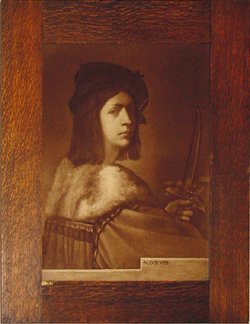
The Violinist
Artist: Sanzio Raphael (1483-1520)
Location: Hall from room 219 to 221
Catalog #109
Notes: Original on wood in Palazzo Sciarra-Conlonna, Rome. In the original of this bust the sitter wears a black cap, from under which his brown hair falls on a green mantle trimmed with black velvet and a fur collar. The violin bow, the laurel leaves, and immortelles in his hand balance the composition. Critics believe the portrait to represent Andrea Marone, a famous improviser at Brescia in the time of Pope Leo X.

Westminster Abbey, London
Artist: James Alphge Brewer
Location: Hall near room 345
Catalog #397
Notes: Westminster's wide-spreading transept is essentially English in plan and detail. This etching shows the beauty achieved through perfect proportion and originality in tracery, as well as by the lancet form of window. Yet the pointed arch and stained glass remind the observer of French influence. The abbey has undergone construction at different dates. The southern transept contains Poet's Corner, where are the tombs and honorary memorials of many of England's great poets from Chaucer to Kipling.

William Shakespeare
Artist: Leopold Flameng (1831-1911)
Location: room 231
Catalog #7
Notes: This steel engraving adds variety to our collection. The vignettes of Edwin Booth and David Garrick, two great actors of America and England, respectively, illustrate a style of earlier art particularly interesting. About Shakespeare the artist has engraved this quotation: "He was not for an age, but for all time."

Age of Discovery
Artist: Denis Eden
Location: Hall between room 117 to 119
Catalog # 71
Notes: Class of January, 1915. Original hangs in the House of Parliament, London. This picture shows King Henry VII of England granting a charter in 1496 to John Cabot and his three sons, authorizing them to sail in search of new lands.
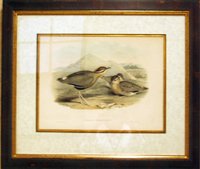
Artist: Hulimandel & Waton, Imp
Location: Hall from room 115 to 113
Catalog # n/a
Notes: Class of 1973

Audubon Society - Numernius Rutescens
Artist: Walter & Cohn, Imp
Location: Hall from room 115 to 113
Catalog # n/a
Notes: Class of 1973

Beatrice of Cuznace
Artist: Sir Anthony Van Dyck (1599-1614)
Location: Hall from room 343 to window
Catalog # 404
Notes: Chiefly accomplished in technical skill, Van Dyck gave consummate care and labor to the details of this portrait. Contrast the emphasis on costume and his fondness for splendor with the lack of depth in his study of character.

Bridge and Town
Artist: Wihhelm Blanke
Location: Hall from room 133 to 135
Catalog # 382
Notes: The artist has been sensitive to the fascination of a castle. Here is an Old World scene where the castle dominates the town. Impressive, enduring, though its feudal usefulness has ceased, it stands yet. Durableness is expressed in the stone bridge, too, through repetition of the arches and by the massiveness of its pillars. Strong contrasts in color complete the atmosphere of rugged strength.

Burgos Cathedral, Spain (Interior)
Artist: James Alphege Brewer
Location: Hall from room 345 to 345
Catalog # 398
Notes: In a golden light, this etching delicately expresses the vastness and richness of Burgos Cathedral in which the adornment of carvings, statues, and paintings reveal an interweaving of Christian and Moorish detail. Among its many tombs are those of Don Fernando and the Cid, both famous heroes in Moorish wars.

Castle of the Maidens
Artist: Edwin A. Abbey (1852-1911)
Location: Hall from room 229 around corner
Catalog # 219
Notes: Class of June, 1917. Original in Boston Public Library. In cool, ethereal colors, these maidens, representing the virtues, form a horizontal band. This serves as background to the warm, dynamic red of Galahad's cloak. He has come to rescue the maidens from imprisonment by the seven deadly sins.

Close of Day
Artist: Karl Ludwig (1839-1901)
Location: room 117
Catalog # 306
Notes: Among the modern paintings in our collection this is one of the most impressive because of atmosphere produced by light. As the few cottages, rendered beautiful by snow, fade in the twilight, the mountains remain lighted by the setting sun. Its rays are extended and alternated by shadows like an echo rolling from peak to crag. Lines, shadows, and softness of light produce a startling effect.

Dance of the Nymphs
Artist: Jean Babtiste-Camille Corot (1796-1875)
Location: room 107
Catalog # 22
Notes: Class of June, 1912. Original in the Louvre, Paris. This shows the lyric spirit that pervades Corot's work. Aiming at the general effect of the impressionists, he painted landscapes that are full of mist and sunshine. Strict contours are abolished and edges blurred as the indistinct mass of the foliage shows.

Death of Nelson (October 21, 1805)
Artist: Daniel Maclise (1806-1870)
Location: room 201 / Balcony Entrance
Catalog # 238
Notes: Original in the House of Parliament, London. This picture portrays the death of perhaps the greatest English seaman in the naval battle of Trafalgar. The picture shows Nelson surrounded by some of the members of his crew. Maclise sought to represent the incident as it may have happened.

Dutch Interior
Artist: Pieter de Hooghe (1632-1681)
Location: Hall from room 121 to 123
Catalog # 426
Notes: Class of January, 1913. Original in London. Hooch was an early master of full sunlight, light and shade, painting them with great truth and beauty. Simple scenes like this he used as a framework on which to lay his beautiful, rare color and subtle atmosphere.

The Erythrean Sibyl
Artist: Michelangelo (1475-1554)
Location: Hall from room 211 to 213
Catalog # 408
Notes: The Erythrean sibyl, from Babylonia, is a beautiful, draped form. The sibyls are exalted figures that know no other kin, as if they were self-creators. In the spiritual colors of the sibyl of Babylonia, one arm extended, on arm relaxed, is an imposing figure.

Fisherman's Wife
Artist: Hans Von T. Bartels (1856-1913)
Location: Hall from room 121 to 123
Catalog # 345
Notes: Along the beach during low tide, a fisherman's wife gathers driftwood while her husband nets fish. Thus they obtain food and fuel. Strong lines and compact forms reveal the superb strength of these serious folk. The child's movement toward the toy boat is the only line of action away from that duty. The picture's imaginative quality lies in the suggestion that the purple shadow enshrouds the central figure as a symbol of her hardships, but at the same time accents the beauty of color through which she tries to express herself. In contrast, the sunlight falling on the group of figures in the background animates the scene.

Ganymede
Artist: Henry O. Walker (1843-1929)
Location: Library / room 002
Catalog # 323
Notes: Original in the Library of Congress, Washington DC. This portrays Milton's Comus, an enchanter, son of Circe, as he breaks off his riotous revels on hearing the Lady's song. The warm, vibrant light enhances his youthfulness. His pose of rapt attention foreshadows his awakening to the beauty of Virtue.

Grand Canal, Venice
Artist: n/a
Location: Hall from room 319 to 321
Catalog # 257
Notes: Donated by the Class of 1919. This is a photograph of the canal, with St. Mark's in the distance.
Herman Beare Portrait (Picture not available)
Artist: J. Herman Beare
Location: room 229
Catalog # n/a
Notes: Donated by the Class of January, 1907

Hieroglyphics
Artist: John W. Alexander (1856-1915)
Location: Library / room 002
Catalog # 250
Notes: Donated by the Class of June, 1919. Original hangs in the Congressional Library, Washington, DC. The center of interest is the hieroglyphics the Egyptian stone cutter is chiseling upon the face of a monumental tomb. The proportion of the background is occupied by the face of the stone and the focus of light on it bring the work, rather than the worker, into prominence. His face is turned to his work. His companion, a shadowed observer lost in absorbing interest over the meaningful symbols, balances the inspired action of the writer. The sharp silhouette of the pyramid in the distance repeats the permanency of the message.
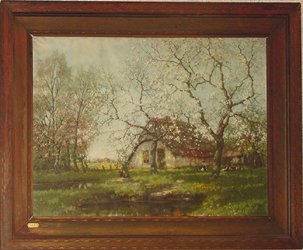
In the Spring
Artist: A.M. Gorter (1866-1933)
Location: Hall from room 313 to 315
Catalog # 299
Notes: The beauty of this cottage, with the apple trees blossoming in the dooryard, fills the observer with emotion, like the melody of My Old Kentucky Home. The composition's arrangement is restful and its coloring soft.

Jeune Homme Lisant (Young Man Reading)
Artist: Rembrandt Van Rijn (1606-1669)
Location: Hall from room 323 to 325
Catalog # 115
Notes: Donated by the Class of January, 1915. Original at Copenhagen, Denmark. This painting illustrates another problem in handling illumination and arranging composition.

At Katwijk, Holland
Artist: William Ritschel (1864-?)
Location: room 201
Catalog # 280
Notes: In this color etching, there are trees, some crooked and some straight. Under the trees the shepherd and his sheep take refuge from a storm.

Lady Dudgeon
Artist: Sir Henry Raeburn (1756-1823)
Location: room 146
Catalog # 271
Notes: Raeburn, a contemporary of Reynolds and Gainsborough, portrayed the substantial, finer qualities of women of breeding in an enjoyable, simple technique. He blocked out his forms in a firm manner, but his work remains a substitute for the camera in setting up the vain ego of the titled classes.

The Last Supper
Artist: Leonardo da Vinci (1452-1419)
Location: Hall from room 227 to 229
Catalog # 308
Notes: Original fresco in Milan, Italy. The setting of "The Last Supper" is a monastic dining hall where moral repose reigns. Jesus has just said, "One of you shall betray Me". The company at this tranquil, holy table falls into consternation. The picture portrays the effect of this proclamation of tragedy as it pierces the souls of the apostles. To this effect, every detail contributes: the lighting, the architecture, the bare walls converging to carry us directly into the scene; the heads; the gestures; the faces; the perspective - all lines converging to the inclined head of Christ with downcast looks; the whole attitude; the motion of the arms; the hands. Everything seems, with heavenly resignation, to repeat: "Verily, verily, there is one among you that betrays Me."
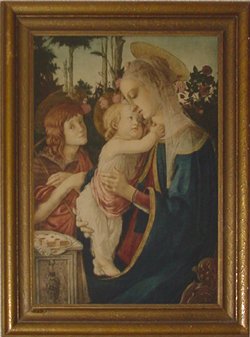
The Madonna and St. John
Artist: Alessandro Filepepi Botticelli (Sandro)(1447-1510)v
Location: Hall from room 223 to 225
Catalog # 318
Notes: Donated bye the Class of January, 1913. In a painting by Botticelli, we find beauty of pure line and a graceful rhythm that few artists have attained. He does not always intend to be true to nature. We cannot judge his figures entirely from the standpoint of realism. He uses his strong decorative sense to give us a beautiful pattern. Its flowing line yields more rhythm than strength but always it is graceful in the highest degree. His style is individual, the rhythmic use of sensitive line being its chief characteristic.

Mime's Hohle (Mime's Cave)
Artist: Hermann Hendrick (1856-1931)
Location: Hall from room 334 to 338
Catalog # 57
Notes: Donated by the Class of June,1913. With characteristic feeling the story of the hero, Siegfried, is introduced. The discouragement with which Mime is hammering at a sword intended for Siegfried is dimly perceived in the gloom of the cave.

Mountain Waterfall
Artist: n/a
Location: room 213
Catalog # n/a
Notes: No information available.
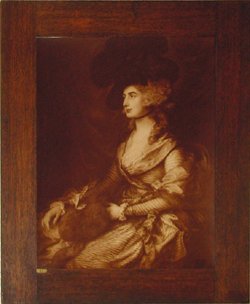
Mrs. Scott Siddons
Artist: Sir Thomas Gainsborough (1727-1788)
Location: Hall from room 343 to 345
Catalog # 40
Notes: Original in National Gallery, London. As a portrait painter Gainsborough was the only rival of the great Sir Joshua Reynolds. This portrait of Mrs. Siddons is one of Gainsborough's finest portraits. The lines are decisive, yet graceful and delicate. Her blue and buff striped silk dress resembles "the dark water of the sea with sunshine on it". Gainsborough's great purpose was to render the effect of decorative light and color.

The New Learning
Artist: F. Cadogan Cooper
Location: Hall between room 104 to 105
Catalog # 72
Notes: Donated by the Class of January, 1915. The colorful court of Henry VII is a vivid background for the black gown of Erasmus the scholar. In this picture of a fifteenth century scene, the scroll in the center is of interest.

November
Artist: A.M. Gorter (1866-?)
Location: room 117
Catalog # 45
Notes: Donated by the Class of January, 1915. This picture is an interesting study in color. The black structure of bare trees adds a sharp contrast to the delicate light that hints of the bleakness of approaching winter.

Origin of Parties: Picking the Red and White Rose in the Old Temple Garden
Artist: Henry A. Payne
Location: Hall between room 104 to 105
Catalog # 73
Notes: Donated by the Class of January, 1915. Original in Houses of Parliament, London. This picture shows an incident that transpired a little before the outbreak of the War of the Roses. During the reign of King Henry IV there were two parties in the royal court: the Lancastrians and the Yorkists. The former, favoring the queen and Somerset, wore a red rose as badge; the latter, favoring the Duke of York, wore a white rose. In this painting representatives of the two factions are picking the red and the white roses in Temple Gardens.

Per Aspera Ad Astra (Through Difficulties to the Stars)
Artist: K.W. Dieffenbach
Location: room 038
Catalog # 332
Notes: Original at Capri, Italy. The masses leap into a triangular design and run and whirl.

Per Aspera Ad Astra (Through Difficulties to the Stars)
Artist: K.W. Dieffenbach
Location: room 038
Catalog # 334
Notes: Original at Capri, Italy. Balance and rhythm sustain the youthful rope walkers. Note the use of the triangle in the composition.

Per Aspera Ad Astra (Through Difficulties to the Stars)
Artist: K.W. Dieffenbach
Location: archives room
Catalog # 336
Notes: Original at Capri, Italy. The accent in this picture is upon the girl with the wand as she tries to break the spell of the piper. The monkey aids her; the goose continues; the crow hesitates

Pierre et Jean (St. Peter and St. John)
Artist: Eugene Burnand (1850-1951)
Location: Hall from room 223 to 225
Catalog #14
Notes: Donated by the Class of January, 1913. Through the illumined faced and the dynamic figures of the two apostles of Jesus, this realistic portrayal records a powerful, spiritual experience. The balance in the arrangement sharply contrasts the personalities of John and Peter, seen in great movement.
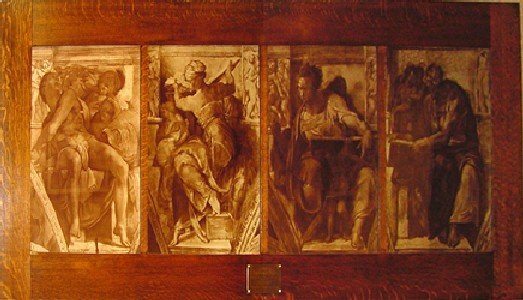
The Prophets (from Creation)
Artist: Michelangelo (1475-1564)
Location: Hall from room 331 to stairs
Catalog #101
Notes: Memorial to Grace Grant McIlvanie, Librarian in the school, 1903-1908. Original on ceiling of Sistine Chapel in the Vatican, Rome. 1. The Cumean sibyl, in Italy, according to legend, asked the gods for immortality, but failed to ask for eternal youth; hence her aged form and face. As she reads, her lips seen to move. 2. Daniel writes in the heat of divine inspiration. Every movement is of great moment. His motions suggest enthusiasm and youthful energy. 3. The Libyan sibyl displays freedom of movement combined with vigor as she turns to grasp a huge volume. 4. Jonah, symbol of immortality, has come forth from the whale, and with his fingers counts the forty days that still remain before the destruction of Nineveh.
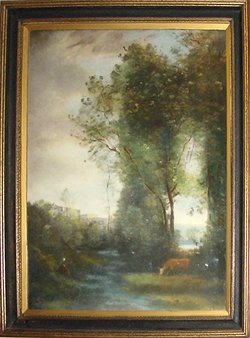
Quiet Afternoon
Artist: Jean Baptiste-Camille Corot (1796-1875)
Location: Hall from room 033 to 035
Catalog #256
Notes: Donated by the Class of January, 1919. Like all of Corot's pictures, this is in subdued and fused colors. It typifies the virginal quality of his landscapes.

Richard Wagner 1813-1883
Artist: n/a
Location: Hall from room 334 to 338
Catalog #210
Notes: Donated by the Class of January, 1913. This German composer created the modern music drama. Note that keenness, refinement, and kindness are prominent in the face of this great musician, whose life was full of disappointments. His immortal creations have enriched the world.

Rouen Cathedral, France
Artist: Andrew Affleck
Location: Hall from room 233 to 235
Catalog #395
Notes: Donated by the Class of June, 1918. A different view from that of catalog entry 399 (below).

The Shepherd of the Pyrenees
Artist: Marie Rosa Bonheur (1822-1899)
Location: room 05
Catalog #9
Notes: Donated by the Class of June, 1912. Rosa Bonheur is chiefly of interest as a woman painter of animals. In her compositions of vigorous action and interesting rhythm there are no traces of a woman's hand.

Singing Boys
Artist: Franz Hals (1580-1666)
Location: Hall from room 219 to 221
Catalog #49
Notes: Donated by the Class of June, 1916. Original in Berlin, Germany. The facility of Hals's skill is expressed through another realistic group as these urchins to the tones that are implied by their attention and by their attitude.

St. Jean Baptiste (St. John the Baptist)
Artist: Andrea del Sarto (1486-1531)
Location: Hall from room 213 to 215
Catalog #128
Notes: Donated by the Class of January, 1915. Original in Pitti Palace, Florence, Italy. This picture owes its atmosphere to subtle light and shades and to the quiet distinction of the youthful John. Sarto was called "the faultless painter" for his skill as draftsman, brushman, and colorist; but in the art of bringing "feeling" to the observer, he often is disappointing.

Sunrise
Artist: Harry A. Vincent (1864-?)
Location: Archive Room
Catalog #285
Notes: The artist undoubtedly felt the freshness of early morning when the sun tinges the atmosphere with warm colors. The cool, green masses of trees in the foreground contrast harmoniously with the lighter shades in the horizon, where the attention of the observer is directed.

Surf and Spindrift
Artist: Fred J. Waugh (1861-?)
Location: room 225
Catalog #288
Notes: A contemporary but conservative American painter, Waugh excels in marines/seascapes. His ability to interpret the might of the sea and its joyous aspect makes this picture a typical example of his painting.

Swiss Village
Artist: Emma Lampert Cooper
Location: hall from room 133 to 135
Catalog #260
Notes: Donated by the Class of 1919. This favorite theme of the American artist is full of variety. She found inspiration in street scenes like this. In the composition, there is a feeling of stability in the high-walled cottages and bridge, gladdened by the stream and warm sunshine. The eye is led to the background of trees and to the distant sky. Orange-yellow colors, strong lines, and strong masses make visible a harmonious adjustment of the villagers.

Venice
Artist: Frank Brangwyn (1867-?)
Location: room 138
Catalog #355
Notes: Original in private collection, Los Angeles. The romantic past of Venice lives in the beauty of her old buildings. The repetition of the vertical lines accented by the flag, pictures the traditional pomp and power of Venice. The many figures in the foreground are suggested with simplicity. The proudly-floating, vermilion flag enhances the effect of the whole.

The Vision
Artist: Edwin A. Abbey (1852-1911)
Location: South East stairway, 2nd floor
Catalog #2
Notes: Donated by the Class of June, 1908. Original in Boston Public Library. This picture tells the story of the vision of the infant, Galahad. He is visited by a dove bearing a golden censer and by an angel carrying the Grail. The nun holding the infant represents his connection with the earth; the angel, the principal figure, represents his inspiration from heaven. The ideal of the true mural is fulfilled in the flat, decorative background.
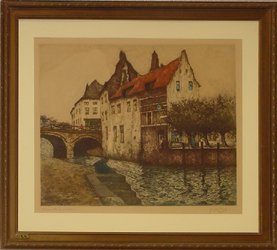
Wharf at Sil
Artist: Julien Celos (1884-1953)
Location: n/a
Catalog #388
Notes: Signed Original. Celos interprets background as it relates to the persons within it. The well-proportioned house, surrounded by stream and trees and sky and bridge, blends happily with the bright colors of the figures. Their movement and arrangement affect the observer pleasingly.

William Shakespeare
Artist: n/a
Location: room 113
Catalog #259
Notes: Donated by the Class of January, 1919

Age of Innocence
Artist: Sir Joshua Reynolds (1723-1792)
Location: Hall from room 029 to 031
Catalog # 124
Notes: Original in National Gallery, London. Aiming at effect rather than likeness, Reynolds felicitously interpreted childhood through harmony of line; through shade, soft and broad; and through color, rich and warm. This picture conveys a sense of ease not found in his other portraits. His claim to fame rests upon his portraits of children.

Audubon Society - Pluvianus Aegyptius
Artist: Walter Imp
Location: Hall from room 115 to 113
Catalog # n/a
Notes: Class of 1973
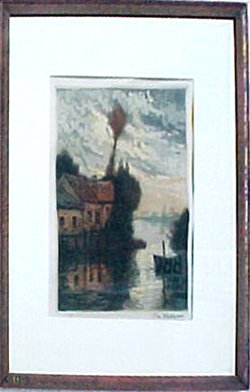
The Border of the River
Artist: Pierre Waidman
Location: room 146 H
Catalog # 143
Notes: The etching's fine line helps to give this color reproduction a delicate quality. It is a tranquil scene, quiet waters in the foreground offset by the restless motion of clouds in the sky of evening.

Broadway
Artist: C.C. Cooper (1856-
Location: room 146
Catalog # 237
Notes: Class of June, 1918. Cooper, "the poet of cities", finds inspiration in the streets of a modern metropolis. For him there are beauty, grandeur, and sublimity in skyscrapers. "He clothes the commonplace brick and mortar of the business block with warm, rich colors of their own". This reproduction is representative and typical of his work.

The Cairn
Artist: John W. Alexander (1856-1915)
Location: Library / room 002
Catalog # 248
Notes: Class of June, 1919. Original in Congressional Library, Washington, DC. This portrays prehistoric man, commemorating some notable event merely by erecting a heap of boulder on the seashore. The flowing lines convey the impression that he is in action and that he is earnest, intelligent, and full of zest from his ennobling ideas. His companions, receding into the background, by contrast express less response to the appeal of great deeds. The color and light emphasize the vitality of primitive man in relation to the vigor and mystery of nature when he is surrounded by stone, wind, sun, and sea.
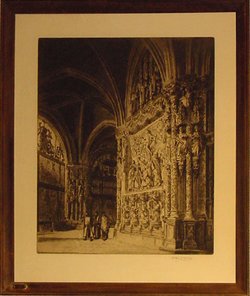
Cathedral Interior
Artist: Arthur Trinwell
Location: Hall from room 345 to 345
Catalog # 405
Notes: This etching depends on line, light, and shade.

Comus, The Enchanter
Artist: Henry O. Walker (1843-1929)
Location: Library / room 002
Catalog # 324
Notes: Original in Library of Congress, Washington. This portrays Milton's Comus, an enchanter, son of Circe, as her breaks off his riotous revels on hearing the Lady's song. The warm, vibrant light enhances his youthfulness. His pose of rapt attention foreshadows his awakening to the beauty of Virtue.

Daniel
Artist: Michelangelo (1475-1564)
Location: Hall from room 211 to 213
Catalog # 407
Notes: This picture reveals that the keynote of Daniel's prophecy was hope. Daniels writes in the heat of divine inspiration. Every movement is of great moment. His motions suggest enthusiasm and youthful energy.

The Delphic Sibyl
Artist: Michelangelo (1475-1554)
Location: Hall from room 211 to 213
Catalog # 370
Notes: Original fresco in Sistine Chapel, The Vatican. Through tracing a line that begins at the turban and extends on the right to the base of the picture and then to the left, you will find that this composition is an oval. Into it the details of drapery and form are drawn masterfully.

Early Autumn
Artist: George Traver (1864-1928)
Location: Hall from room 313 to 315
Catalog # 302
Notes: The richness of various colors and the pleasing composition in this woodland scene suggest the fulfillment of autumn's beauty.

The Fair
Artist: Josse Goosens (1876-?)
Location: room 148
Catalog # 362
Notes: This painting captures the moos of a carnival with its lively motion and color. Both are presented in a bold, gay pattern, -definitely a pattern rather than a realistic painting. There are many figures, but detail has been omitted because color and life are the more important features. The broad, sure strokes in tree and sky provide interesting texture and a dark and light scheme strong enough to balance the riot of color in the crowd below. "The Fair" combined gaiety in conception, structure, and technique.

Flight of the Heron
Artist: George Innes (1825-1894)
Location: Hall from room 311 to 313
Catalog # 243
Notes: Class of June, 1918. The golden light flooding this picture creates an atmosphere at once tranquil and remote. The feeling of the out-of-doors is emphasized by the heron, which also gives life and interest. Inness was the greatest among American's early painters of landscape.

Founding Bank of England (1694)
Artist: George Harcourt (1868-?)
Location: Hall between room 104 to 105
Catalog # 70
Notes: Class of June, 1915. Original in Houses of Parliament, London. Discussion of the plans for founding the Bank of England engages the attention of the principals, William Paterson and Charles Montagu.

Girl with Pearl
Artist: Jean Babtiste-Camille Corot (1796-1875)
Location: Hall from room 125 to 127
Catalog # 416
Notes: Original in the Louvre, Paris. Versatility is a well-known characteristic of artists. This picture is an excellent example of Corot's portraiture though he is chiefly known as a master among painters of landscape.

Gutenberg
Artist: John W. Alexander (1856-1915)
Location: Library / room 002
Catalog # 253
Notes: Donated by the Class of June, 1919. Original in the Congressional Library, Washington DC. Color-chords and an indistinct background showing the printing press indicate the importance of the forces released when printing began. Gutenberg, the reputed inventor of the printing press, is reading a "proof" that has just come from the press. Clear, bright light on the paper focuses the observer's attention upon the printed page.

The Holy Family
Artist: Bartolome Murillo (1617-1682)
Location: room 223-221
Catalog # 314
Notes: This picture, in Murillo's usual pyramidal form, is strong in contrasts: the idealized forms of Jesus and John the Baptist; the youthful Mary and the experienced Elizabeth, the mothers. These probably are portraits of Andalusian peasants known to Murillo. The human and the divine are blended into a happy family scene, notwithstanding the seriousness of the theme. This is illustrated by prophetic lines and religious symbols.

Isaiah
Artist: Michelangelo (1475-1564)
Location: Hall from room 211 to 213
Catalog # 406
Notes: This picture shows the desire of the prophet Isaiah to comfort his people. Isaiah, his arm resting on a book, pivots in a sudden movement. He turns as if a divine inspiration has roused him from reverie. The design is a harmonious whole. The figure shows the solidity of human architecture.
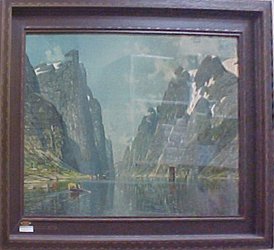
Jhoerring Fjord
Artist: A. Norman
Location: room 050
Catalog # 309
Notes: This realistic picture convinces the observer of the grandeur and majesty of nature as it appears in the lofty crags of a Norse fjord.

King John Signing the Magna Carta
Artist: Ernest Normand (1857-1923)
Location: room 201 / Balcony Entrance
Catalog # 67
Notes: Donated by the Class of January, 1915. Original in House of Parliament, London. This picture portrays an important event in the history of the liberty of the people. King John constantly made outrageous demands of his nobles and of the people. As a result, the chief barons met and swore to compel him to restore the liberties of the realm and confirm them by charter. On June 15, 1215, representatives of the barons met King John at Runnymede and forced him to sign Magna Carta, "The Great Charter", written in Latin. Today its principles are part of the constitution of every English speaking nation.

A Landscape
Artist: H Gohler
Location: room 131 to 133
Catalog # 187
Notes: This study composes a pleasing landscape in which the light and dark masses are well-proportioned. The arrangement tends to be horizontal with a pleasing opposition of lines in the trees. Interest centers in the life depicted because of the highest values in the sail boat together with the most vivid colors in the flowers at the cottage.

The Lifting Fog
Artist: Henry A. Vincent (1864-1931)
Location: Hall from room 131 to 133
Catalog # 349
Notes: In this decorative picture, ships hold the attention because of their patterns and composition in color in a momentary gleam of light penetrating the fog.

Manchurian Warriors
Artist: Alan Hunt
Location: room 146
Catalog # 318
Notes: Donated by the Class of 1991

The Manuscript
Artist: John W. Alexander (1856-1915)
Location: Library / room 002
Catalog # 252
Notes: Donated by the Class of June, 1919. Original in Congressional Library, Washington, DC. In this picture, the strongest emphasis falls on the writing in the manuscript portrayed through the intense attention of the monk and further emphasized by the dim light. With all brilliancy of color withdrawn from the narrow cloister, the tireless patience of the scribes of the middle ages in producing the illumined pages glorifies labor.

Mona Lisa
Artist: Leonardo da Vinci (1452-1419)
Location: Hall from room 227 to 229
Catalog # 218
Notes: Donated by the Class of June, 1917. Original in Louvre, Paris. Leonardo da Vinci, though architect, engraver, scientist, and sculptor, primarily was a painter and the princely leader of the Italian Renaissance. His "Mona Lisa" not only is one of the world's most celebrated portraits but is one of the most difficult to understand. Her smile -- subtle, sphinx-like, and unreadable -- is not the expression of a woman's mood. It baffles our utmost effort to understand. From one angle it seems tender; from another, cynical. Life's whole range is interpreted in the face of this woman whose brain is alert and whose soul is animated. The hands are exquisitely modeled. A symbolically suggestive landscape forms the background. "Mona Lisa" is da Vinci's attempt to create an articulate and convincing expression of the mystery of life.
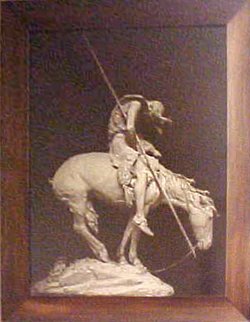
Native American
Artist: n/a
Location: West Hall to Auditorium
Catalog # n/a
Notes: No information available

Nibelheim
Artist: Hermann Hendrick (1856-1931)
Location: Hall, corner to room 332
Catalog # 53
Notes: Donated by the Class of June,1913. In the sharp contrast to the bright gardens of heaven is Nibelheim, the dark, underground home of Alberich, the dwarf, who stole the Rheingold. In the gloomy light from the forge the ugly tyrant stares greedily at the magic ring fashioned by Mime, the artful goldsmith, who holds it on his sword. This baleful ring, which brings unhappiness to all who possess it, is the center of interest.

October Days
Artist: Harry A. Vincent (1867-1931)
Location: room 201
Catalog # 283
Notes: The bright, cool shades in this October light show the growth in landscape painting from the earlier French schools.

Oral Tradition
Artist: John W. Alexander (1856-1915)
Location: Library / room 002
Catalog # 249
Notes: Donated by the Class of June, 1919. In this picture of an oriental story-teller relating the tale to absorbed hearers, Alexander develops man's further awakening. In implied lines the inspired speaker point to an unseen horizon where momentous events took place beyond the wall the circumscribes him. Shadows in the foreground repeat this note of the unseen. The yellow light in the distance carries the mind afar to the imagined scene of traditional action.

Peace Celebration at Strassburg
Artist: Lewis Orr (1879-)
Location: hall from room 345 to 345
Catalog # 313
Notes: Critics use brilliancy as the word that best describes the American Orr's work. As in this etching, "he compels attention through sweep and swing". He is distinguished by the "fact that he is approximately the fourteenth American artist to have work admitted to the Luxembourg Gallery, that he has a greater number of works there than any other of the American group, and that one of his etchings, 'The canal de Monnaie', probably was the first work of fine art by a living American to be purchased for the National Musee de Louvre". His technique mainly is pure line work.
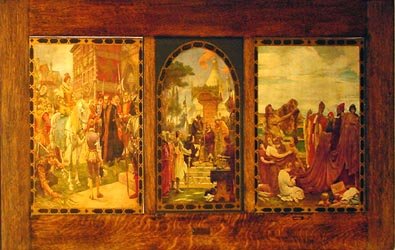
Phoenicians Trading with Early Britons
Artist: Frederic Leighton (1830-1896)
Location: room 201 / Balcony Entrance
Catalog # 68
Notes: Donated by the Class of January, 1915. Original in Houses of Parliament, London. Barter, in early history, is illustrated in this picture. The Phoenicians are exchanging trinkets and manufactured goods with the Britons for tin, needed in early welfare for armor and weapons.

Prince Rhodekanakis
Artist: Sir Anthony Van Dyke (1599-1614)
Location: Hall from room 343 to 345
Catalog #140
Notes: Original at Vienna. This picture shows a typical, rather trite portrait pose. Notice again the interest of the painter in details of costume.

The Prophets (from Creation)
Artist: Michelangelo (1475-1564)
Location: Hall from room 331 to stairs
Catalog #99
Notes: Memorial to James Fenimore Cooper, a former teacher in the school. Original on ceiling of Sistine Chapel in the Vatican, Rome. In the Renaissance, Michelangelo became the supreme artist of all time. Primarily a sculptor, not considering painting "his art", he reluctantly accepted the commission thrust upon him by Pope Julius II to cover the ceiling of the Sistine with paintings in fresco. Michelangelo besought the pope to employ Raphael. But after entering upon the enterprise, he discovered that his imagination was unleashed and that "his world might be extended into illimitable space, retaining the strength and certainty of sculpture and enriched by color". To cover ten thousand square feet of ceiling is an enormous undertaking; to organize this area into a structural unit is the work of one who from the depth of his soul is an artist. The design called for three hundred and forty-three figures. About two hundred and twenty-five range in height from ten to eighteen feet. In the decorations of the Sistine he has bequeathed the greatest, single hand work of art that man had produced. The intricate, architectonic system combines single figures and groups of figures, whose actions symbolize the creation of the world, man's first disobedience, and the prophecies of redemption. The prophets are grouped as follows: 1. The powerful Jeremiah, seated in at attitude of serious reflection, exemplifies Michelangelo's nobility of conception. The two spirits behind the prophet seem to sympathize with him. 2. Alternating with the prophets are the sibyls, the prophetesses of classical antiquity, who have prophesied the birth of a Christ. The Persian sibyl, aged and near-sighted, is reading. 3. Ezekiel's form expressed the urge of an impetuous questioning that arose while the prophet was reading the scroll, now half open. The spirit seems to be pointing out One who is to come. 4. The Erythrean sibyl, from Babylonia, is a beautiful, draped form. The sibyls are exalted figures that "know no other kin", as if they were self-creators. Above, a spirit uses the torch to set the oil in the lamp afire. All movement is directed toward the finger on the scroll.

The Rains - Tiger
Artist: John Seerey-Lester
Location: room 212
Catalog #n/a
Notes: No information available.

The Rising Storm
Artist: G. Maroniez (1865-1933)
Location: Hall from room 121 to 123
Catalog #315
Notes: This picture is unified to present the atmosphere of a storm by means of lurid light, lowness in the key of color, and use of diagonal lines to show agitated motion and the engulfing waters.

Rouen Cathedral, France
Artist: Andrew Affleck
Location: Hall from room 345 to 345
Catalog #399
Notes: The artist gave full play to his powers in etching the rich and varied designs and decorations of this Gothic cathedral.

Siegfried and Fafnir
Artist: Hermann Hendrick (1856-1931)
Location: Hall from room 334 to 338
Catalog #58
Notes: Donated by the Class of June,1913. The contrast between the strength of the youthful Siegfried and that of Giant Fafner, in the shape of a dragon, is balanced by the lines that reveal the youth's godlike power and the dragon's venom. By position and by light Siegfried's success is emphasized. The sword, Nothung, is the symbol of his power.

Sistine Madonnas
Artist: Sanzio Raphael (1483-1520)
Location: room 117
Catalog #360
Notes: Original in Dresden Gallery, Germany. Raphael painted a Virgin incomparably more beautiful than any other of the admirable Virgins he had painted before. This is a transcendently beautiful picture of a heavenly apparition surrounded the glory of lovely angel faces. He used the traditional, triangular arrangement to express the formal relations of line and mass. Every figure, though interesting in itself, is significant for the part it has in the whole. He connected the figures by continuing in the contour of the Virgin. The lines descend by the billowing mantle and gaze of St. Barbara. They are reflected up to the Christ Child by the gaze of the cherubs.

Sunset on the Lake
Artist: Leon Batrooche
Location: Hall from room 311 to 313; duplicate in room 119
Catalog #401
Notes: The sunset flattens the water and the land. Only the trees are able to stand up under the leveling rays of the setting sun.

The Syndics
Artist: Rembrandt Harmenszoon van Rijn (1607-1669)
Location: Hall from room 323 to 325
Catalog #120
Notes: Original in Ryks Museum, Amsterdam, Holland. In this group the Dutch master Rembrandt achieved his greatest perfection. Free from affection, simple and even in light, convincing in its fidelity to life, the picture seems a group of living men. Every object has its plain and define local color; yet the whole is steeped in a brownish golden tone that gives the charm of color that Rembrandt alone captured.

The Syndics - a Detail
Artist: Rembrandt Harmenszoon van Rijn (1607-1669)
Location: Hall from room 323 to 325
Catalog #113
Notes: Donated by the Class of June, 1915. Original in Ryks Museum, Amsterdam. This picture shows in detail the perfection of Rembrandt's portraiture.

Venice
Artist: Pierre Labrouche
Location: Hall from room 319 to 321
Catalog #402
Notes: In this etching Labrouche, who has the contemporary interest in depth and solidity, added joyous feeling to the atmosphere of Venice through strong color, heavy lines and excellent design.

Waldweban Forest Murmers
Artist: Hermann Hendrick (1856-1931)
Location: Hall, corner to room 332
Catalog #59
Notes: Donated by the Class of June,1913. Having killed Fafner (Hate), Seigfried sits as master of the world, and all wisdom is open to him. A woodbird tells him that Mime intends to poison him in order to obtain the treasure and that the sleeping Brunnehilde is to be his bride.

White Cow
Artist: Constant Troyon (1810-1865)
Location: room 105
Catalog #135
Notes: Class of January, 1913. Troyon's theme is the close relation of cattle to nature. Here he conveys a feeling of concord between the cow and the tree that provides shade and comfort.

William, the Second, of Nassau
Artist: Sir Anthony Van Dyck (1599-1614)
Location: Hall from room 343 to 345
Catalog #141
Notes: Original in Dresden Gallery, Germany. This portrait of Flemish master Van Dyck's generous patron and bestower of knight hood conveys an impression of the kingly presence of this English monarch through particular emphasis upon the nobleness of his bearing and the dignity of his countenance. The king wears the mantle of the Order of the Garter on which is the six pointed, silver star. At the star's center is the red cross of St. George. The gold medallion about his neck is a "George", the image of the martial saint.
